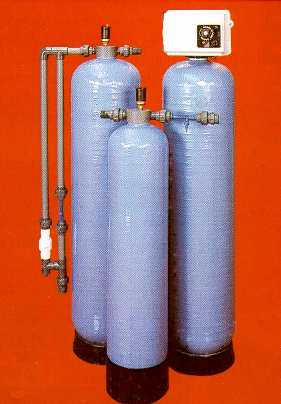

Reverse Osmosis is a process that is often described as filtration. Although it is not actually that (see below) it is used to "filter" out of solution a wide range of contaminants.
The reverse osmosis plant will not, typically, be used for softening water or for de-chlorination and needs to be supplied with water already softened and de-chlorinated if it is to operate efficiently.
Osmosis is the process by which nutrients feed the cells in our bodies and how water gets to the leaves at the top of trees. If you separate a solution of salts from pure water using a thin semi-permeable membrane like a sausage skin, the pure water passes through the membrane and tries to dilute the salt solution. If the salt solution is connected to a vertical pipe then the progressively diluted solution will fill the pipe until the "osmotic
pressure" drawing the pure water through the membrane is the same as the head of solution. This process can be reversed - hence "Reverse Osmosis" - by applying a higher pressure to the salt solution. Pure water will then pass the other way through the membrane in a process that is easy to visualise as "filtration" where the filter will only let through the small water molecules and retain almost all of the other molecules.
Nano-Filtration by membrane separation is essentially the same as Reverse Osmosis with slightly larger "holes" in the semi-permeable membrane.
The rejection rate of the contaminants in the water by Reverse Osmosis units will vary from 80% to over 95% and can be as good as 99.5% for some metal ions. Permeate water can then be economically "polished" with a disposable Deionisation resin to achieve even higher levels of purity.
System Management
Reverse Osmosis systems in their basic form consist of a pressure pump and a high pressure housing containing a semi-permeable membrane. Water is forced into the housing under pressure and pure water or "permeate" collected from an outlet and routed to service. Rejected water or "concentrate" is collected from another outlet and routed to the drain. In order to keep the volume of rejected water to a minimum, commercial Reverse Osmosis systems recycle a proportion back to the inlet of the pump. The proportion of permeate made from the total volume of feed water is known as the "recovery rate" and will vary from 15% to 80% depending on the type of water being treated and the design of other treatment plant associated with the system.
Specifying and Sizing
The pressure at which the system will need to operate will vary according to the salinity of the raw water. Commercial Reverse Osmosis systems with "Tap Water" membranes can deal with a Total Dissolved Solids (TDS) of up to 2,000 mg/1 and operate at around 200-250 p.s.i. A TDS of up to 11,000 mg/1 as described as "Brackish" and needs a pressure of 400-500 p.s.i. to produce pure water. Sea water has a TDS of over 30,000 and requires specially reinforced membranes and 1000 p.s.i.) to work effectively.
Nano-Filters need lower pressures to operate and the production rate is higher with a contaminant rejection rate of around 80% depending on the mix of dissolved solids. Nano-Filtration is used as an alternative to softening without the handling problems associated with ultra pure water. By leaving a low level of minerals in the product water, Nano-Filters avoid the need for remineralisation to prevent corrosion in potable or general service supplies.
Reverse Osmosis and Nano-Filtration Plant must be supplied with de-chlorinated and softened water or de-chlorinated raw water treated with an anti-scalant. A duplex water softener is recommended for continuous operation. High output reverse osmosis plant offers considerable advantages over traditional Deionisation systems, with no acid/caustic consumables, continuous output with no regeneration downtime, and no problems with COSHH compliance. If softened service water is needed elsewhere on the same installation site, concentrate water can be returned to a softened water holding tank, eliminating water wastage.
Technical Details and Part Numbers
| Model | PC4 | PC8 | PC12 | PC16 | PC32 | PC48 | PT60 | PT90 | PT120 |
| Output per 22 hours.m3/day |
4 | 8 | 12 | 16 | 32 | 48 | 60 | 90 | 120 |
| Nano Filtration Systems |
NF6 | NF12 | NF18 | NC24 | NF48 | NF72 | NT90 | NT135 | NT180 |
| Output per 22 hours.m3/day |
6 | 12 | 18 | 24 | 48 | 72 | 90 | 135 | 180 |
Footprint Pro-Compact 34" x 28" (860x710mm), Pro-Twin 72" x 28" (1830x710mm). PC 32 illustrated).
Special Product Features:
Output range from 1m3/day to 360m3/day
Microprocessor controller
Continuous conductivity monitoring and readout
Low pressure cutout
High conductivity cutout/low conductivity cutout
High pressure cutout
High pressure pump
Low water level alarm/startup
High & low pressure gauges
Cleaning stations
Permeate and concentrate flow gauges
Automatic flushing
High flow activated carbon chlorine/organics filter
Total run accumulator
Rugged powder coated welded steel frame
Low voltage solenoids
High water level cutout
Compact size with minimal footprint